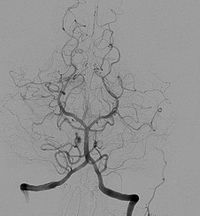
Photo from wikipedia
While carotid artery longitudinal wall motion (CALM) has been highly detailed in cross-sectional studies, there is little evidence to explain population inter-individual variability. This study was conducted to investigate how… Click to show full abstract
While carotid artery longitudinal wall motion (CALM) has been highly detailed in cross-sectional studies, there is little evidence to explain population inter-individual variability. This study was conducted to investigate how common external factors impact CALM. Twenty-one young healthy adults (11 females, aged 22±2 years) underwent three within-subject protocols. To evaluate probe positioning, vascular ultrasound was performed at a proximal and distal location along the common carotid artery. To evaluate neck angle, scans were acquired with the neck positioned at 70°, 90°, maximum extension (112±9°), and maximum flexion (51±7°). For the respiratory cycle condition, scans were taken during 7 sec of inhalation, 7 sec of exhalation, and 7 sec of breath hold. CALM was evaluated for anterograde, retrograde, and maximum displacements, as well as radial-axial displacement. CALM was greater at proximal vs. distal locations (retrograde = 1.14±0.62 vs. 0.63±0.24 mm, maximal = 1.32±0.59 vs. 0.73±0.24 mm; all p<0.05). Minimum neck angles had greater motion than maximum angles (maximum displacement = 1.03±0.43 vs. 0.77±0.23 mm, p<0.05). Without correcting breathing bias, retrograde displacement was greater during inspiration vs. expiration (1.06±0.34 vs. 0.58±0.24 mm) and breath hold (1.06±0.34 vs. 0.58±0.24 mm), diastolic CALM was greater during expiration vs. breath hold (1.10±0.44 vs. 0.76±0.33 mm), and maximum CALM was smaller during breath hold vs. expiration (0.89±0.31 vs. 1.21±0.39 mm) and inspiration (0.89±0.31 vs. 1.41±0.70 mm). We recommend scanning 1-2 cm proximal to the carotid bifurcation, maintaining a neutral neck angle (70-90°) for optimal CALM data collection in humans.
Journal Title: Journal of applied physiology
Year Published: 2022
Link to full text (if available)
Share on Social Media: Sign Up to like & get
recommendations!